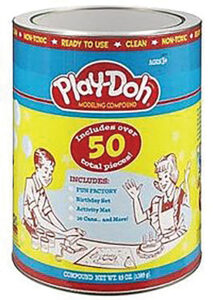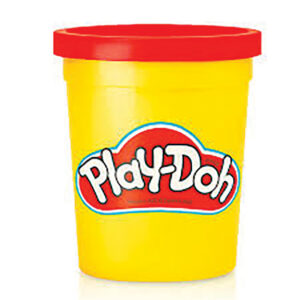 Did you know that the earliest versions of Play-Doh were once used to clean wallpaper? The Kutol company of Cincinnati originally invented Play-Doh in the 1930s as a product to be rolled over wallpaper to remove dirt without damaging the paper. Later, vinyl wallpapers could be cleaned with water, so the product fell out of use until a teacher with family ties to the company used it with her preschool class to make Christmas ornaments. The company removed detergents from the recipe, added color and scent and changed the name to give it the new identity that we know today!
Did you know that the earliest versions of Play-Doh were once used to clean wallpaper? The Kutol company of Cincinnati originally invented Play-Doh in the 1930s as a product to be rolled over wallpaper to remove dirt without damaging the paper. Later, vinyl wallpapers could be cleaned with water, so the product fell out of use until a teacher with family ties to the company used it with her preschool class to make Christmas ornaments. The company removed detergents from the recipe, added color and scent and changed the name to give it the new identity that we know today!It was reworked and marketed to Cincinnati schools in the mid-1950s. Play-Doh was demonstrated at an educational convention in 1956 and prominent department stores opened retail accounts.
Play-Doh became a modeling compound for young children to make arts and crafts projects at home. Play-Doh advertisements promoting Play-Doh on influential children’s television shows in 1957 furthered the product’s sales. Since its launch on the toy market in the mid-1950s, Play-Doh has generated a considerable amount of ancillary merchandise.
The non-toxic, non-staining, reusable modeling compound that came to be known as “Play-Doh” was a pliable, putty-like substance concocted by Noah McVicker of Cincinnati-based soap manufacturer Kutol Products. It was devised at the request of Kroger Grocery which wanted a product that could clean coal residue from wallpaper.
Following World War II, with the transition from coal-based home heating to natural gas and the resulting decrease in internal soot, and the introduction of washable vinyl-based wallpaper, the market for wallpaper cleaning putty decreased substantially.
 McVicker’s nephew, Joe McVicker, was the brother-in-law of nursery school teacher Kay Zufall, who had seen a newspaper article about making art projects with the wallpaper cleaning putty. Her students enjoyed it, and she persuaded Noah McVicker and Joe McVicker to manufacture it as a child’s toy. Zufall and her husband came up with the name Play-Doh; Joe McVicker and his uncle Noah had wanted to call it “Rainbow Modeling Compound.”
McVicker’s nephew, Joe McVicker, was the brother-in-law of nursery school teacher Kay Zufall, who had seen a newspaper article about making art projects with the wallpaper cleaning putty. Her students enjoyed it, and she persuaded Noah McVicker and Joe McVicker to manufacture it as a child’s toy. Zufall and her husband came up with the name Play-Doh; Joe McVicker and his uncle Noah had wanted to call it “Rainbow Modeling Compound.”














Follow Us